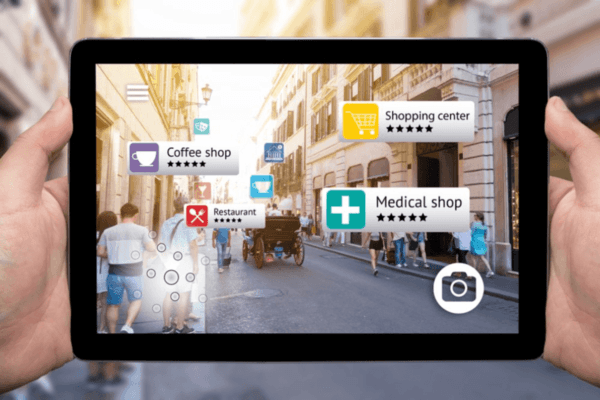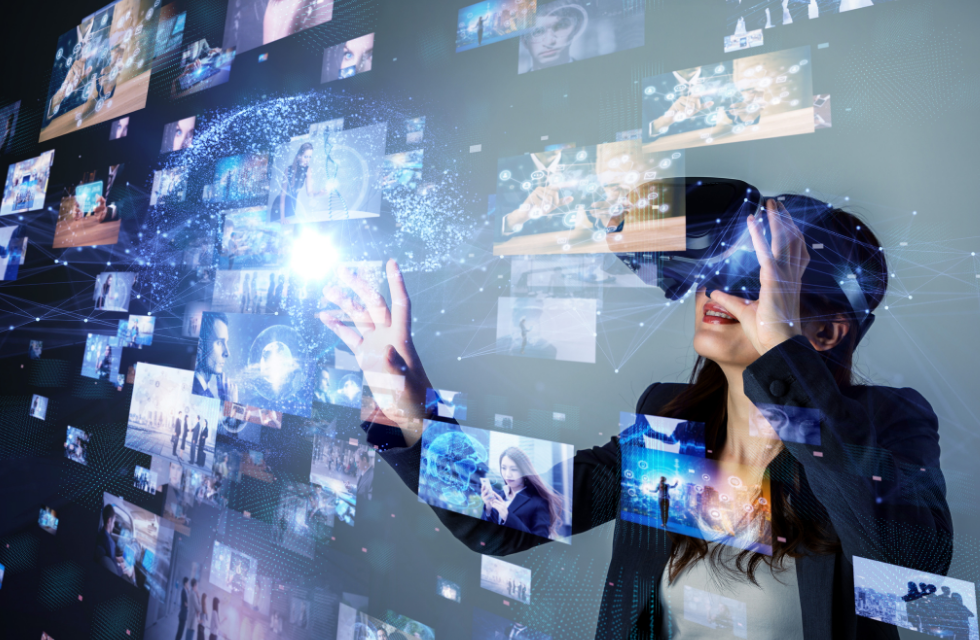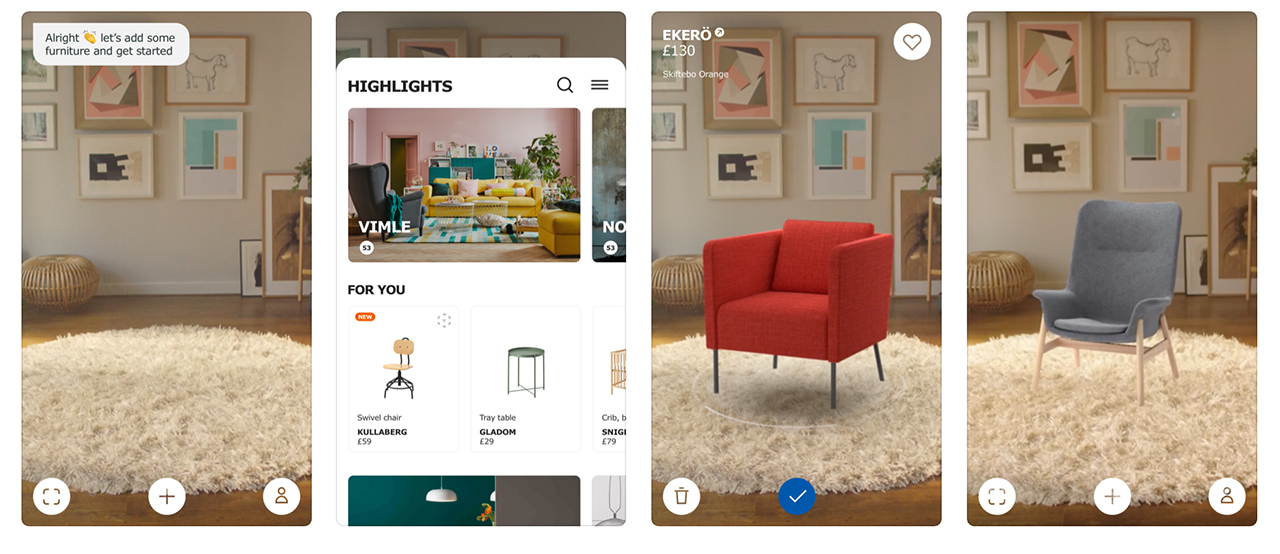
Revolutionizing Engagement: How AI Marketing Transforms Email Campaigns
August 28, 2023
Unveiling the Power of Real-Time Data Analysis in AI Marketing: A Game-Changer for Success
August 29, 2023In today’s ever-evolving digital landscape, where consumers are bombarded with constant information, marketers are trying to capture and maintain their audience’s attention. This pursuit has led to the emergence of novel and dynamic strategies, and at the forefront of this revolution is the integration of Augmented Reality (AR) and Artificial Intelligence (AI) in marketing efforts. This blog post aims to explore, in intricate detail, how these technologies are revolutionizing the field of AI marketing by creating immersive brand experiences that engage and resonate with consumers on a profound level.

Understanding Augmented Reality and Its Evolution
Defining Augmented Reality
Augmented Reality, often abbreviated as AR, is a groundbreaking technology that merges the digital and physical worlds. Unlike Virtual Reality (VR), which transports users to entirely virtual environments, AR enhances the real world by superimposing digital elements. This can include images, videos, 3D models, and interactive features. Imagine pointing your smartphone at a city street and seeing restaurant reviews, historical facts, or even virtual characters populating your screen.
Historical Development of AR
AR might seem like a recent innovation, but its roots can be traced back to the 1960s. The visionary Morton Heilig created the “Sensorama” in 1962, a device that combined 3D visuals, stereo sound, and even aromas to simulate immersive experiences. However, in the 21st century, AR truly began to capture the public imagination. Launching applications like Pokemon Go in 2016 marked a turning point, making AR accessible to millions through smartphones. This paved the way for AR’s integration into daily life and marketing strategies.
The fusion of AI with AR technology takes this innovation even further. By harnessing the power of AI algorithms, AR experiences become visually captivating, personalized, and deeply engaging. The integration of AI allows for real-time analysis of user behavior and preferences, enabling marketers to curate tailored AR content that resonates with individual consumers.

The Role of AI in Enhancing Augmented Reality Marketing
AI-powered Data Analysis for Personalization
At the core of AI’s impact on AR marketing lies its ability to analyze vast amounts of data in real time. AI algorithms can sift through user data, including browsing history, purchase patterns, and social media interactions, to understand each consumer’s preferences and behaviors. This data-driven insight empowers marketers to deliver highly personalized AR experiences that align with individual tastes.
Consider a scenario where a customer enters a retail store equipped with an AR app. Thanks to AI, the app can instantly analyze the customer’s past purchases, browsing history, and preferences to offer customized product recommendations. This level of personalization enhances user engagement and increases the likelihood of conversion. Users are more likely to respond positively to content that directly resonates with their interests, making AI-powered AR marketing a potent tool for brand loyalty and customer satisfaction.
Real-time Content Generation with AI
Creating captivating AR content requires creativity, technical expertise, and agility. AI addresses this challenge by enabling real-time content generation based on user interactions and environmental factors. For instance, consider an AR app that offers users interactive 3D animations. With AI, the app can respond to users’ movements and gestures, generating dynamic visuals that adapt to their actions.
Imagine using an AR app to explore an art gallery virtually. AI algorithms can analyze the user’s gaze and interactions to provide additional information about the artworks being viewed. This on-the-fly content generation ensures that users remain engaged and excited as they navigate the virtual gallery. Such experiences are not only visually stimulating but also foster a sense of discovery and interactivity.
Predictive Analytics and Customer Insights
AI’s predictive capabilities extend beyond personalization. Marketers can leverage AI to analyze historical data and identify patterns that forecast future consumer behavior. By understanding trends and preferences, brands can design AR campaigns that resonate with their target audience.
Imagine a fashion retailer preparing for a seasonal collection launch. The retailer can anticipate which styles, colors, and materials will likely be popular by utilizing AI-powered predictive analytics. This knowledge informs the creation of AR experiences that showcase these favored elements, leading to increased user engagement and conversions. Moreover, the insights gained from AI-driven analytics can inform broader marketing strategies, resulting in more effective campaigns across various channels.
Natural Language Processing for Interactive Experiences
One of AI’s most remarkable capabilities is Natural Language Processing (NLP). NLP empowers computers to understand and interpret human language, enabling seamless interactions between users and technology. When integrated with AR, NLP takes user engagement to unprecedented levels.
Imagine a restaurant employing an AR-powered menu. Users can point their devices at the menu items and verbally inquire about ingredients, allergens, or recommendations. NLP-enabled AR understands the user’s speech, processes their query, and provides relevant information. This transforms the dining experience from a mere transaction to an interactive and informative engagement.
By harnessing AI’s NLP capabilities, brands can facilitate meaningful conversations with their customers through AR, fostering deeper connections and enhancing brand loyalty.

Applications of AR and AI in Marketing
Interactive Product Visualization
The marriage of AI and AR has unleashed a powerful tool for businesses, especially those in the e-commerce sector. Interactive product visualization allows customers to experience products in a virtual environment before purchasing.
Consider a scenario where a customer is considering buying furniture online. Using an AR app, they can visualize how a particular sofa would fit in their living room. The app can suggest complementary pieces based on the customer’s decor. This eliminates the uncertainty associated with online shopping, as customers can now assess size, color, and style in their own space.
This application of AI-powered AR not only empowers customers to make informed decisions but also reduces the likelihood of returns. Additionally, it enhances user engagement, as customers interact more deeply with products in a virtual yet personalized context.
Virtual Try-On Experiences
The beauty and fashion industries have harnessed the potential of AI-powered AR to provide virtual try-on experiences. This application addresses a common challenge of online shopping: the need to physically try on products before purchasing.
For instance, consider a cosmetics brand offering a virtual makeup try-on through an AR app. AI algorithms analyze facial features and skin tones to recommend makeup products that suit the user. In real-time, the user can then visualize how different lipstick shades, eyeshadow, and blush would look on their face.
This technology enhances the shopping experience by allowing customers to experiment with different looks and shades without needing physical samples. Moreover, it boosts customer confidence in their purchase choices, increasing sales and brand loyalty.
Location-based AR Campaigns
Location-based marketing has been a staple in the marketing world, but AI-powered AR takes it to new heights. By analyzing user data and real-time location information, brands can deliver hyper-targeted AR experiences that capture consumers’ attention in specific physical locations.
Imagine walking by a coffee shop and receiving an AR notification on your smartphone. The notification offers a discount on your favorite beverage if you step inside within the next 15 minutes. This engages users and drives foot traffic to the physical store.
By integrating AI, brands can refine their targeting strategies based on consumer behaviors and preferences. This ensures that AR campaigns are contextually relevant and offer tangible benefits to consumers.
Gamification and Engagement
Gamification has proven to be an effective strategy for boosting user engagement and interaction. With AI-powered AR, brands can create immersive gamified experiences that captivate users and convey brand messages playfully and interactively.
Imagine an AR-based treasure hunt organized by a retail brand. Using an app, users can follow clues in the real world to find virtual rewards and discounts. The AI algorithm can adjust the difficulty of the clues based on the user’s progress, ensuring a challenging yet enjoyable experience.
This combination of gamification and AI-driven personalization keeps users entertained and invested in the brand’s story. As users immerse themselves in the game, they become more receptive to the brand’s messaging, leading to increased brand awareness and customer loyalty.

Creating Immersive Brand Experiences: Case Studies
IKEA’s Furniture Placement App
Ikea, the global furniture giant, recognized the potential of AI-powered AR to solve a common problem its customers face: visualizing how furniture would fit into their homes. The company developed an AR app allowing users to place furniture items in their living spaces virtually.
Users can see how each piece fits the existing layout by scanning the room and selecting furniture from Ikea’s catalog. AI algorithms ensure the scale, proportions, and placement are accurate, giving customers a realistic preview of their potential purchase. This innovative app not only simplifies the decision-making process but also adds an element of excitement and interactivity to furniture shopping.
Sephora’s Virtual Makeup Try-On
Sephora, a global beauty retailer, tapped into the potential of AI-powered AR to transform the cosmetics shopping experience. The company developed an app that allows users to try different makeup products in real time virtually.
Through facial recognition and AI analysis, the app accurately maps facial features and realistically applies virtual makeup. Users can experiment with shades of lipstick, eyeshadow, and foundation, all while receiving personalized recommendations based on their skin tone and preferences. This immersive try-on experience engages users and provides them with valuable insights into how different products will look on their skin.
Sephora’s AI-powered AR app bridges the gap between online and in-store shopping experiences, offering customers a new and innovative way to explore and purchase beauty products.
Pepsi’s AR Campaign: A Taste of the Future
Pepsi, a global beverage brand, harnessed the power of AR to create a memorable and interactive brand experience. The company transformed a mundane bus shelter into a futuristic portal using AR technology.
Commuters were met with surprising and delightful AR experiences as they waited at the bus shelter. Virtual creatures, futuristic vehicles, and even a meteor shower were projected onto the shelter’s glass panels, creating an otherworldly ambiance. The AR experience seamlessly blended the physical environment with imaginative digital elements, capturing the attention and curiosity of passersby.
Pepsi’s campaign is a prime example of how AI-powered AR can turn ordinary locations into captivating brand interactions. Brands can forge stronger connections with their audience by evoking emotions and sparking curiosity.
Nike’s AR Sneaker Hunt
The iconic sportswear brand Nike used AI-powered AR to engage its audience innovatively and interactively. The company launched an AR scavenger hunt for limited-edition sneakers, turning the streets of major cities into virtual treasure-hunting grounds.
Participants used the Nike AR app to navigate the city, following clues that led them to virtual sneaker icons scattered across physical locations. Upon finding an icon, users could purchase the corresponding virtual sneaker delivered to their doorstep as a physical product.
The fusion of AI-driven gamification and AR created a unique and engaging experience that transcended the boundaries of the digital and physical worlds. Nike’s campaign demonstrated how brands can leverage technology to create memorable and shareable experiences that resonate with their target audience.

Challenges and Considerations in AI-Driven AR Marketing
Technical Complexities and Integration
The integration of AI and AR in marketing campaigns is a complex endeavor. It requires expertise in AI algorithms and AR development and the ability to integrate the two technologies seamlessly. Technical challenges may arise in real-time data processing, user interactions, and content generation.
To overcome these complexities, businesses must collaborate with skilled professionals with expertise in AI, AR, and software development. Choosing the right technology stack and development framework is crucial for creating a seamless and practical AI-driven AR experience.
Data Privacy and Security Concerns
The marriage of AI and AR involves collecting and analyzing user data, raising essential data privacy and security concerns. Marketers must navigate the regulatory landscape to ensure compliance with data protection laws, such as the General Data Protection Regulation (GDPR) and the California Consumer Privacy Act (CCPA).
It’s imperative that users’ data is collected transparently and used only for the purposes they have consented to. Clear privacy policies and opt-in mechanisms should be in place to safeguard user information and build trust. Businesses can enhance their reputation and maintain strong customer relationships by prioritizing data privacy.
User Experience and Accessibility
While AI-powered AR experiences have the potential to be captivating, they must also be user-friendly and accessible to a diverse audience. Complex interactions, confusing interfaces, or slow performance can lead to user frustration and abandonment.
To create a positive user experience, businesses should focus on intuitive design and streamlined interactions. User testing and feedback are essential in identifying areas for improvement. Moreover, accessibility considerations should be taken into account to ensure that AI-powered AR experiences are usable by individuals with disabilities.
Cost Implications
Developing AI-powered AR marketing campaigns requires financial investment. From hiring skilled professionals to developing custom AI algorithms and AR applications, the costs can add up. Before embarking on an AI-powered AR journey, businesses must assess their budgets and determine the potential return on investment (ROI).
It’s essential to balance the desired features and the available resources. Some businesses might opt for phased implementations or partnerships with AR development platforms to mitigate initial costs. A thorough cost-benefit analysis is essential to ensure that the benefits of AI-driven AR outweigh the expenses.
Ethical Considerations and Regulations
As AI and AR reshape the marketing landscape, ethical considerations and regulatory compliance become increasingly important. Brands must use AI and AR responsibly, avoiding manipulative tactics or deceptive practices.
Transparent communication with users is paramount. Brands should inform users when interacting with AI-powered AR experiences and be transparent about the collected data. Moreover, adhering to ethical guidelines and industry standards will contribute to positive brand perception and credibility.

Steps to Get Started with AI-Powered AR Marketing
Defining Your Objectives
Embarking on an AI-powered AR marketing journey begins with clearly understanding your objectives. Define what you aim to achieve through AR experiences. Are you looking to increase brand awareness, drive sales, enhance user engagement, or all of the above? Setting specific goals will guide your strategy and ensure that the integration of AI and AR aligns with your broader marketing objectives.
Choosing the Right AR Development Platform
The appropriate AR development platform is crucial for a successful AI-powered AR marketing campaign. Consider factors such as ease of use, compatibility with AI integration, and the range of features the platform offers. Evaluate whether the platform supports the creation of interactive and immersive experiences that align with your brand’s vision.
Additionally, assess the platform’s capabilities for data analytics and user behavior tracking. A robust platform should provide insights into user interactions, enabling you to refine and optimize your AR experiences based on real-time feedback.
Integrating AI Capabilities
Integrating AI into your AR experiences is where the magic truly happens. Identify the AI capabilities that align with your objectives. Do you want to offer personalized recommendations, real-time content generation, or predictive analytics? Collaborate with AI experts to develop algorithms that enhance user interactions and tailor the AR content to individual preferences.
For instance, if you’re a fashion retailer, integrating AI can enable virtual try-on experiences with accurate recommendations for clothing and accessories that match the user’s style. The AI algorithm can analyze user preferences and recommend items that align with their fashion choices, creating a seamless and personalized shopping journey.
Testing and Iteration
Before launching your AI-powered AR campaign to the public, thorough testing and iteration are essential. Begin with internal testing to identify any technical glitches, user experience issues, or unexpected behavior. Collect feedback from your testing team to refine and optimize the user journey.
Once you’ve addressed initial concerns, conduct beta testing with a select group of users. Their feedback will provide valuable insights into how real users interact with your AI-powered AR experiences. Use this feedback to make necessary adjustments and enhancements to ensure a smooth and captivating user experience.
Remember that the development process is iterative. Continuously analyze user engagement metrics, behavior patterns, and conversion rates. Regularly update your AR content and AI algorithms based on user responses, staying agile in response to changing user preferences and market trends.

The Future Landscape of AI and AR in Marketing
Rise of Wearable AR Devices
As technology advances, we can anticipate the rise of wearable AR devices that redefine how users engage with the digital and physical worlds. Wearable AR devices, such as smart glasses, provide hands-free interactions, enabling users to seamlessly access AR content without needing a machine.
Imagine a world where consumers can effortlessly receive personalized recommendations and real-time information through their wearable AR devices as they navigate stores, museums, or even while exploring a new city. These devices can create immersive and contextually relevant experiences, opening up new avenues for brands to connect with consumers.
Hyper-Personalization through AI
The fusion of AI and AR has the power to revolutionize personalization in marketing. AI algorithms can analyze massive datasets to uncover intricate user behavior patterns, preferences, and interests. This deep understanding enables hyper-personalization, where AR experiences are uniquely tailored to each individual’s preferences.
Consider a scenario where a user walks into a retail store. The AR app instantly recognizes users and displays personalized product recommendations based on their previous purchases and preferences thanks to AI-driven data analysis. This level of personalization not only enhances user engagement but also fosters a sense of loyalty, as consumers feel truly understood by the brand.
AR and AI in Social Media Marketing
The integration of AI and AR is poised to transform the social media marketing landscape. Social media platforms increasingly incorporate AR features that allow users to interact with brands in new and immersive ways. AI algorithms will be central in curating AR content that resonates with individual users.
Imagine scrolling through your favorite social media platform and encountering an AR experience that lets you virtually try on a new pair of sunglasses or interact with a 3D version of a product. AI-driven algorithms analyze your social media activity and preferences to deliver AR content that aligns with your interests. This dynamic interaction between AI and AR amplifies user engagement and encourages active participation with brands.
Ethical Considerations and Regulations
As AI and AR become integral to marketing strategies, ethical considerations, and regulatory compliance are highly important. Brands must use AI and AR responsibly, respecting user privacy and ensuring transparent data usage.
Transparency is critical to building and maintaining consumer trust. Brands should communicate when AI is used to curate AR experiences and explain how user data is collected and utilized. Adhering to ethical guidelines and regulations safeguards user rights and contributes to positive brand perception and long-term customer relationships.
In conclusion, the symbiotic relationship between AI and AR is reshaping the future of marketing. By leveraging AI’s predictive capabilities, real-time content generation, and personalization alongside the interactive and immersive nature of AR, brands are poised to create captivating experiences that resonate deeply with consumers. The evolution is ongoing, promising a world where marketing campaigns are not just messages but memorable and interactive journeys. As AI and AR continue to advance, brands that embrace these technologies will stand at the forefront of innovation, delivering exceptional value and engagement to their audiences.
Integrating Augmented Reality (AR) and Artificial Intelligence (AI) propels the marketing landscape into uncharted territory. This fusion holds the potential to revolutionize how brands engage with consumers, creating immersive experiences that resonate on a personal level. The possibilities are boundless as AI-driven personalization and real-time content generation become more sophisticated and AR technologies evolve to embrace wearables and hyper-realistic interactions.
To harness the full potential of AI-powered AR marketing, businesses must navigate challenges, set clear objectives, and prioritize ethical considerations. By selecting the right AR development platform, integrating AI capabilities, and continuously iterating based on user feedback, brands can create memorable experiences that capture and retain audience attention.
Looking ahead, the rise of wearable AR devices promises to redefine user interactions with both the physical and digital worlds. Hyper-personalization driven by AI will deepen brand-consumer relationships, while the convergence of AR and social media will introduce novel ways for users to engage with brands.
In this journey of innovation, ethical considerations and regulatory compliance remain paramount. Transparency, user privacy, and responsible data usage are foundational to building trust and sustaining positive brand perception.
The revolution of AI-powered AR marketing is underway, reshaping the boundaries of marketing campaigns and transforming them into immersive narratives. The brands that embrace this revolution will lead the charge in crafting unforgettable experiences, propelling their marketing strategies into the future.


